Toyota Motor Corporation: Crisis Management Case Study Analysis
VerifiedAdded on 2022/11/14
|21
|3355
|386
Case Study
AI Summary
This case study examines Toyota Motor Corporation's crisis management following a major crisis involving product recalls and reputational damage. The report delves into the background of the problem, including technological advancements, changing consumer needs, and the specific incident that triggered the crisis. It defines the problem, presents evidence of its impact on the company's financial performance and brand reputation, and discusses the benefits of effective crisis management, such as protecting brand image and preventing future losses. The study analyzes strategic responses, including denial, evasion of responsibility, reducing crisis offensiveness, corrective measures, and mortification, recommending a combination of corrective and mortification strategies to restore stakeholder trust. It then analyzes the options considered, stakeholder identification, and the social, environmental, and economic impacts of the recommended strategies, along with financial analysis and risk assessment. The study concludes with a discussion of the deliverability of the recommended solution, including commercial, financial, and management aspects, and provides references to support its findings. The case study highlights the importance of proactive crisis management, effective communication, and the need for companies to prioritize stakeholder trust and sustainable business practices to navigate challenges and maintain a competitive edge in the automotive industry.
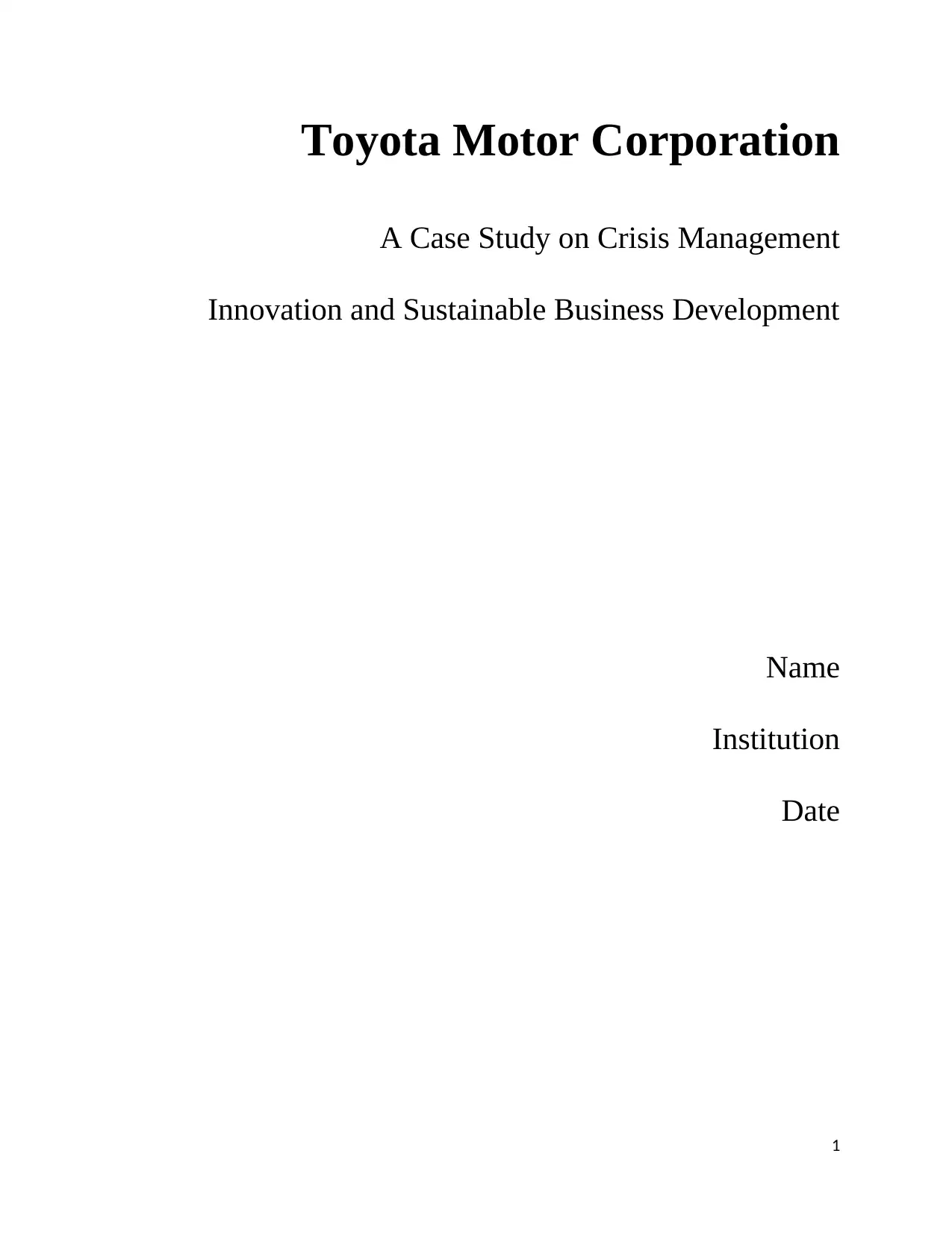
Toyota Motor Corporation
A Case Study on Crisis Management
Innovation and Sustainable Business Development
Name
Institution
Date
1
A Case Study on Crisis Management
Innovation and Sustainable Business Development
Name
Institution
Date
1
Paraphrase This Document
Need a fresh take? Get an instant paraphrase of this document with our AI Paraphraser
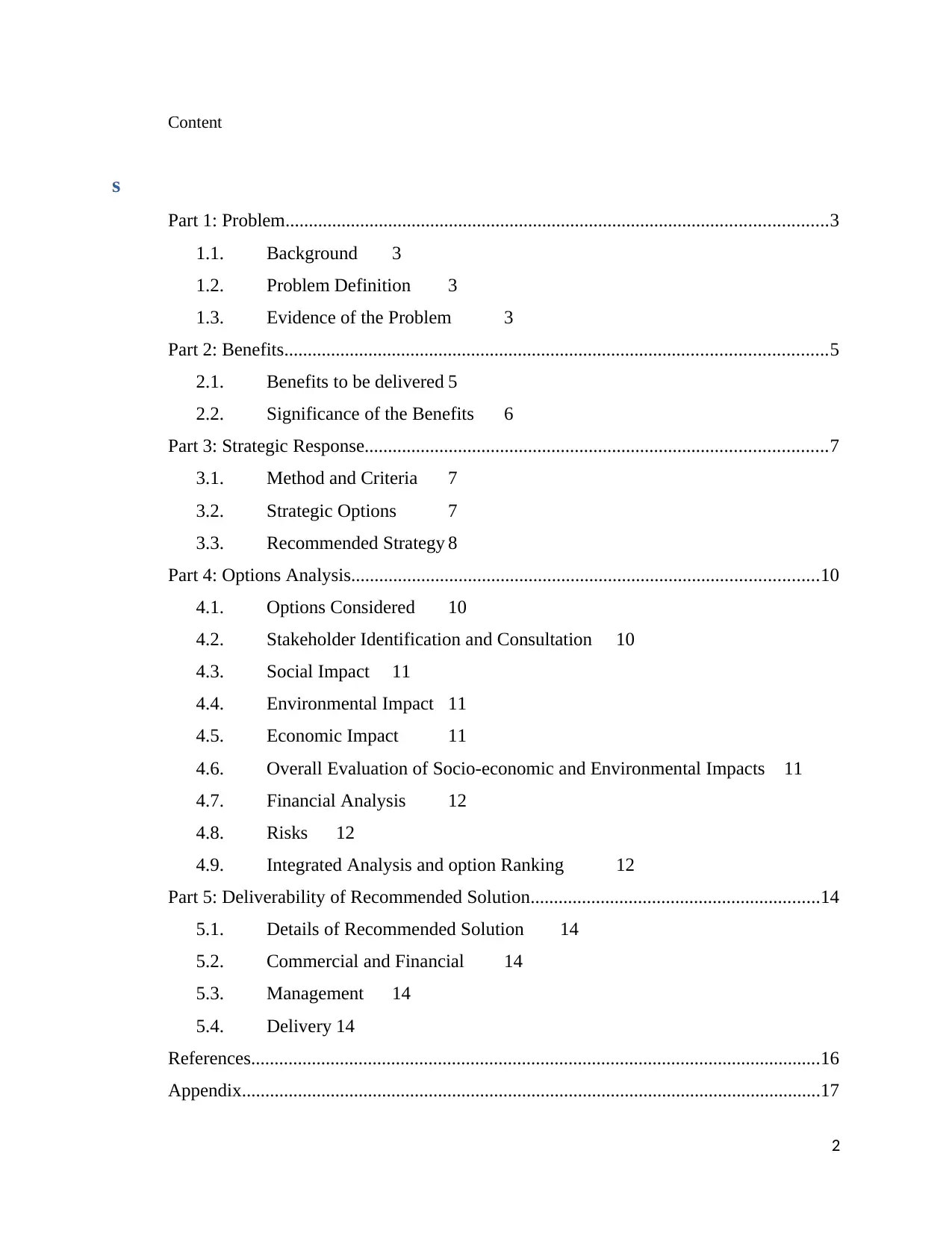
Content
s
Part 1: Problem....................................................................................................................3
1.1. Background 3
1.2. Problem Definition 3
1.3. Evidence of the Problem 3
Part 2: Benefits....................................................................................................................5
2.1. Benefits to be delivered 5
2.2. Significance of the Benefits 6
Part 3: Strategic Response...................................................................................................7
3.1. Method and Criteria 7
3.2. Strategic Options 7
3.3. Recommended Strategy 8
Part 4: Options Analysis....................................................................................................10
4.1. Options Considered 10
4.2. Stakeholder Identification and Consultation 10
4.3. Social Impact 11
4.4. Environmental Impact 11
4.5. Economic Impact 11
4.6. Overall Evaluation of Socio-economic and Environmental Impacts 11
4.7. Financial Analysis 12
4.8. Risks 12
4.9. Integrated Analysis and option Ranking 12
Part 5: Deliverability of Recommended Solution..............................................................14
5.1. Details of Recommended Solution 14
5.2. Commercial and Financial 14
5.3. Management 14
5.4. Delivery 14
References..........................................................................................................................16
Appendix............................................................................................................................17
2
s
Part 1: Problem....................................................................................................................3
1.1. Background 3
1.2. Problem Definition 3
1.3. Evidence of the Problem 3
Part 2: Benefits....................................................................................................................5
2.1. Benefits to be delivered 5
2.2. Significance of the Benefits 6
Part 3: Strategic Response...................................................................................................7
3.1. Method and Criteria 7
3.2. Strategic Options 7
3.3. Recommended Strategy 8
Part 4: Options Analysis....................................................................................................10
4.1. Options Considered 10
4.2. Stakeholder Identification and Consultation 10
4.3. Social Impact 11
4.4. Environmental Impact 11
4.5. Economic Impact 11
4.6. Overall Evaluation of Socio-economic and Environmental Impacts 11
4.7. Financial Analysis 12
4.8. Risks 12
4.9. Integrated Analysis and option Ranking 12
Part 5: Deliverability of Recommended Solution..............................................................14
5.1. Details of Recommended Solution 14
5.2. Commercial and Financial 14
5.3. Management 14
5.4. Delivery 14
References..........................................................................................................................16
Appendix............................................................................................................................17
2

3
⊘ This is a preview!⊘
Do you want full access?
Subscribe today to unlock all pages.

Trusted by 1+ million students worldwide
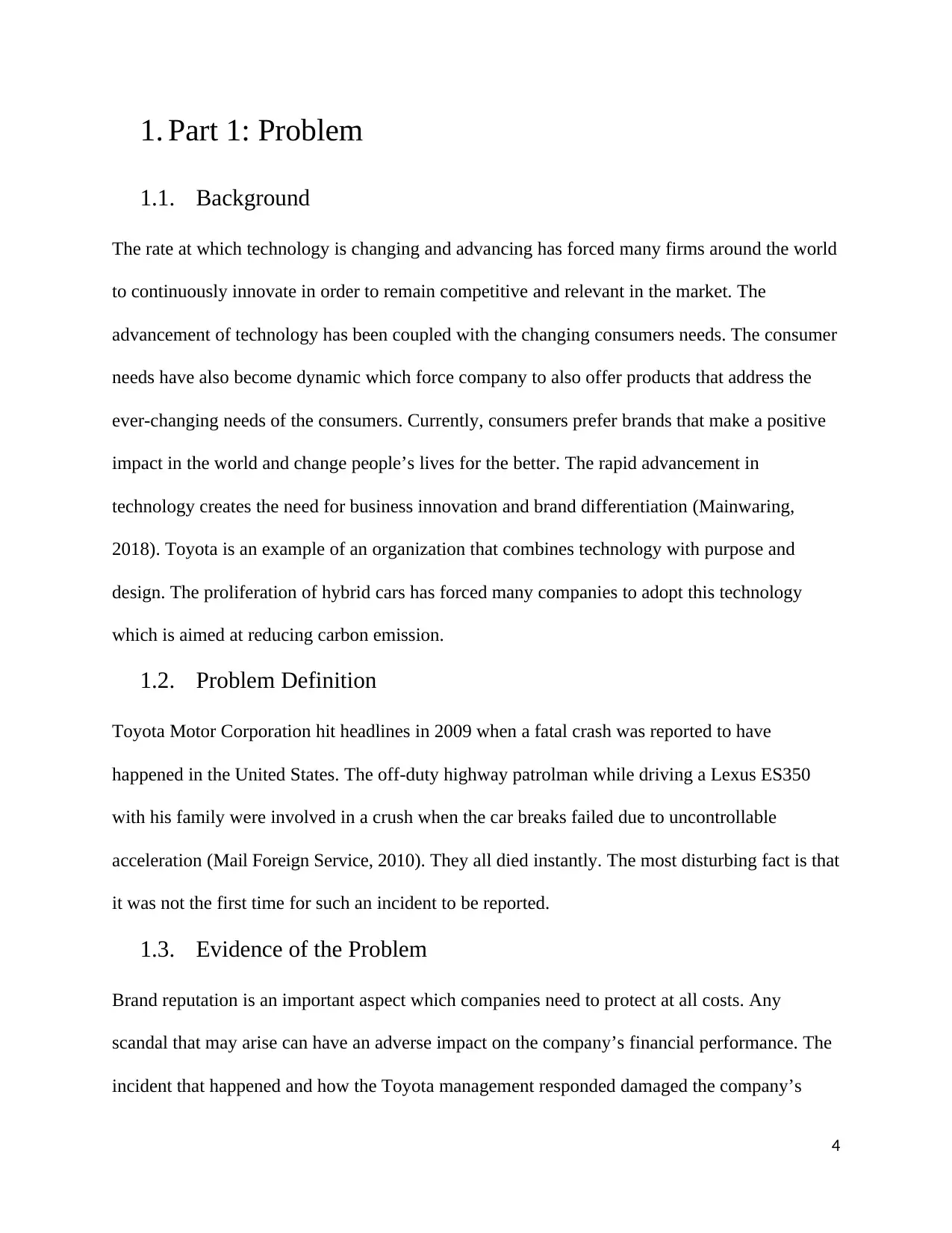
1. Part 1: Problem
1.1. Background
The rate at which technology is changing and advancing has forced many firms around the world
to continuously innovate in order to remain competitive and relevant in the market. The
advancement of technology has been coupled with the changing consumers needs. The consumer
needs have also become dynamic which force company to also offer products that address the
ever-changing needs of the consumers. Currently, consumers prefer brands that make a positive
impact in the world and change people’s lives for the better. The rapid advancement in
technology creates the need for business innovation and brand differentiation (Mainwaring,
2018). Toyota is an example of an organization that combines technology with purpose and
design. The proliferation of hybrid cars has forced many companies to adopt this technology
which is aimed at reducing carbon emission.
1.2. Problem Definition
Toyota Motor Corporation hit headlines in 2009 when a fatal crash was reported to have
happened in the United States. The off-duty highway patrolman while driving a Lexus ES350
with his family were involved in a crush when the car breaks failed due to uncontrollable
acceleration (Mail Foreign Service, 2010). They all died instantly. The most disturbing fact is that
it was not the first time for such an incident to be reported.
1.3. Evidence of the Problem
Brand reputation is an important aspect which companies need to protect at all costs. Any
scandal that may arise can have an adverse impact on the company’s financial performance. The
incident that happened and how the Toyota management responded damaged the company’s
4
1.1. Background
The rate at which technology is changing and advancing has forced many firms around the world
to continuously innovate in order to remain competitive and relevant in the market. The
advancement of technology has been coupled with the changing consumers needs. The consumer
needs have also become dynamic which force company to also offer products that address the
ever-changing needs of the consumers. Currently, consumers prefer brands that make a positive
impact in the world and change people’s lives for the better. The rapid advancement in
technology creates the need for business innovation and brand differentiation (Mainwaring,
2018). Toyota is an example of an organization that combines technology with purpose and
design. The proliferation of hybrid cars has forced many companies to adopt this technology
which is aimed at reducing carbon emission.
1.2. Problem Definition
Toyota Motor Corporation hit headlines in 2009 when a fatal crash was reported to have
happened in the United States. The off-duty highway patrolman while driving a Lexus ES350
with his family were involved in a crush when the car breaks failed due to uncontrollable
acceleration (Mail Foreign Service, 2010). They all died instantly. The most disturbing fact is that
it was not the first time for such an incident to be reported.
1.3. Evidence of the Problem
Brand reputation is an important aspect which companies need to protect at all costs. Any
scandal that may arise can have an adverse impact on the company’s financial performance. The
incident that happened and how the Toyota management responded damaged the company’s
4
Paraphrase This Document
Need a fresh take? Get an instant paraphrase of this document with our AI Paraphraser
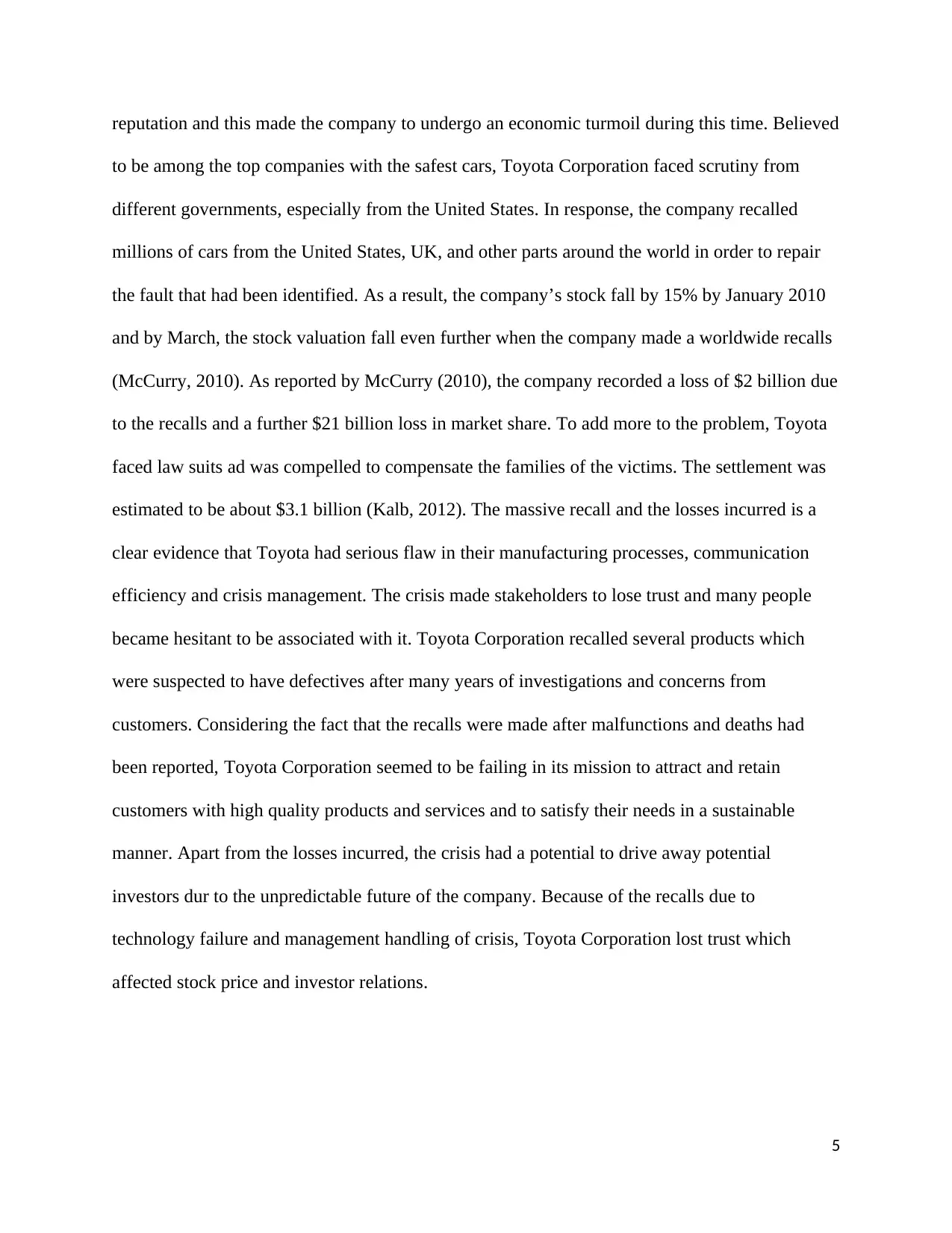
reputation and this made the company to undergo an economic turmoil during this time. Believed
to be among the top companies with the safest cars, Toyota Corporation faced scrutiny from
different governments, especially from the United States. In response, the company recalled
millions of cars from the United States, UK, and other parts around the world in order to repair
the fault that had been identified. As a result, the company’s stock fall by 15% by January 2010
and by March, the stock valuation fall even further when the company made a worldwide recalls
(McCurry, 2010). As reported by McCurry (2010), the company recorded a loss of $2 billion due
to the recalls and a further $21 billion loss in market share. To add more to the problem, Toyota
faced law suits ad was compelled to compensate the families of the victims. The settlement was
estimated to be about $3.1 billion (Kalb, 2012). The massive recall and the losses incurred is a
clear evidence that Toyota had serious flaw in their manufacturing processes, communication
efficiency and crisis management. The crisis made stakeholders to lose trust and many people
became hesitant to be associated with it. Toyota Corporation recalled several products which
were suspected to have defectives after many years of investigations and concerns from
customers. Considering the fact that the recalls were made after malfunctions and deaths had
been reported, Toyota Corporation seemed to be failing in its mission to attract and retain
customers with high quality products and services and to satisfy their needs in a sustainable
manner. Apart from the losses incurred, the crisis had a potential to drive away potential
investors dur to the unpredictable future of the company. Because of the recalls due to
technology failure and management handling of crisis, Toyota Corporation lost trust which
affected stock price and investor relations.
5
to be among the top companies with the safest cars, Toyota Corporation faced scrutiny from
different governments, especially from the United States. In response, the company recalled
millions of cars from the United States, UK, and other parts around the world in order to repair
the fault that had been identified. As a result, the company’s stock fall by 15% by January 2010
and by March, the stock valuation fall even further when the company made a worldwide recalls
(McCurry, 2010). As reported by McCurry (2010), the company recorded a loss of $2 billion due
to the recalls and a further $21 billion loss in market share. To add more to the problem, Toyota
faced law suits ad was compelled to compensate the families of the victims. The settlement was
estimated to be about $3.1 billion (Kalb, 2012). The massive recall and the losses incurred is a
clear evidence that Toyota had serious flaw in their manufacturing processes, communication
efficiency and crisis management. The crisis made stakeholders to lose trust and many people
became hesitant to be associated with it. Toyota Corporation recalled several products which
were suspected to have defectives after many years of investigations and concerns from
customers. Considering the fact that the recalls were made after malfunctions and deaths had
been reported, Toyota Corporation seemed to be failing in its mission to attract and retain
customers with high quality products and services and to satisfy their needs in a sustainable
manner. Apart from the losses incurred, the crisis had a potential to drive away potential
investors dur to the unpredictable future of the company. Because of the recalls due to
technology failure and management handling of crisis, Toyota Corporation lost trust which
affected stock price and investor relations.
5

2. Part 2: Benefits
2.1. Benefits to be delivered
The Toyota crisis is mainly attributed to management ignorance. Toyota Corporation is believed
to have the most complicated manufacturing systems with quality systems installed. However,
one can just ask himself why such a problem could not be detected early enough to avoid deaths
that were reported. The most hurting part is that the management was too slow to respond to the
crisis. When many customers complained about the issue, the company ignored for many years
until the United States decided to conduct investigation on the problem. That’s when the
company decided to respond.
The company needs a crisis management plan that will enable them to effectively handle crisis to
avoid damage of the brand reputation. An effective crisis management plan will enable the
company to protect its brand image and avoid unpredicted losses and loss of market share. The
company will also need an effective quality auditing plan that will enable the technical team to
identify problems before the cars reach the consumers.
It is imperative to note that corporate reputation is the key factor of corporate branding.
Maintaining corporate reputation is essential to the organisation and its stakeholders. The value
of a brand is determined not only by its financial performance but also the intangible assets such
as brand image and reputation. A positive reputation can influence potential customers and
investors to the product or service and can also attract customers from competitors. This will, in
turn, improve financial performance and enable the company to gain a competitive edge against
its rivals. Improving the quality check systems will also prevent accidents and loss of innocent
lives. The crisis management strategy will, therefore, enable the company to maintain its
6
2.1. Benefits to be delivered
The Toyota crisis is mainly attributed to management ignorance. Toyota Corporation is believed
to have the most complicated manufacturing systems with quality systems installed. However,
one can just ask himself why such a problem could not be detected early enough to avoid deaths
that were reported. The most hurting part is that the management was too slow to respond to the
crisis. When many customers complained about the issue, the company ignored for many years
until the United States decided to conduct investigation on the problem. That’s when the
company decided to respond.
The company needs a crisis management plan that will enable them to effectively handle crisis to
avoid damage of the brand reputation. An effective crisis management plan will enable the
company to protect its brand image and avoid unpredicted losses and loss of market share. The
company will also need an effective quality auditing plan that will enable the technical team to
identify problems before the cars reach the consumers.
It is imperative to note that corporate reputation is the key factor of corporate branding.
Maintaining corporate reputation is essential to the organisation and its stakeholders. The value
of a brand is determined not only by its financial performance but also the intangible assets such
as brand image and reputation. A positive reputation can influence potential customers and
investors to the product or service and can also attract customers from competitors. This will, in
turn, improve financial performance and enable the company to gain a competitive edge against
its rivals. Improving the quality check systems will also prevent accidents and loss of innocent
lives. The crisis management strategy will, therefore, enable the company to maintain its
6
⊘ This is a preview!⊘
Do you want full access?
Subscribe today to unlock all pages.

Trusted by 1+ million students worldwide
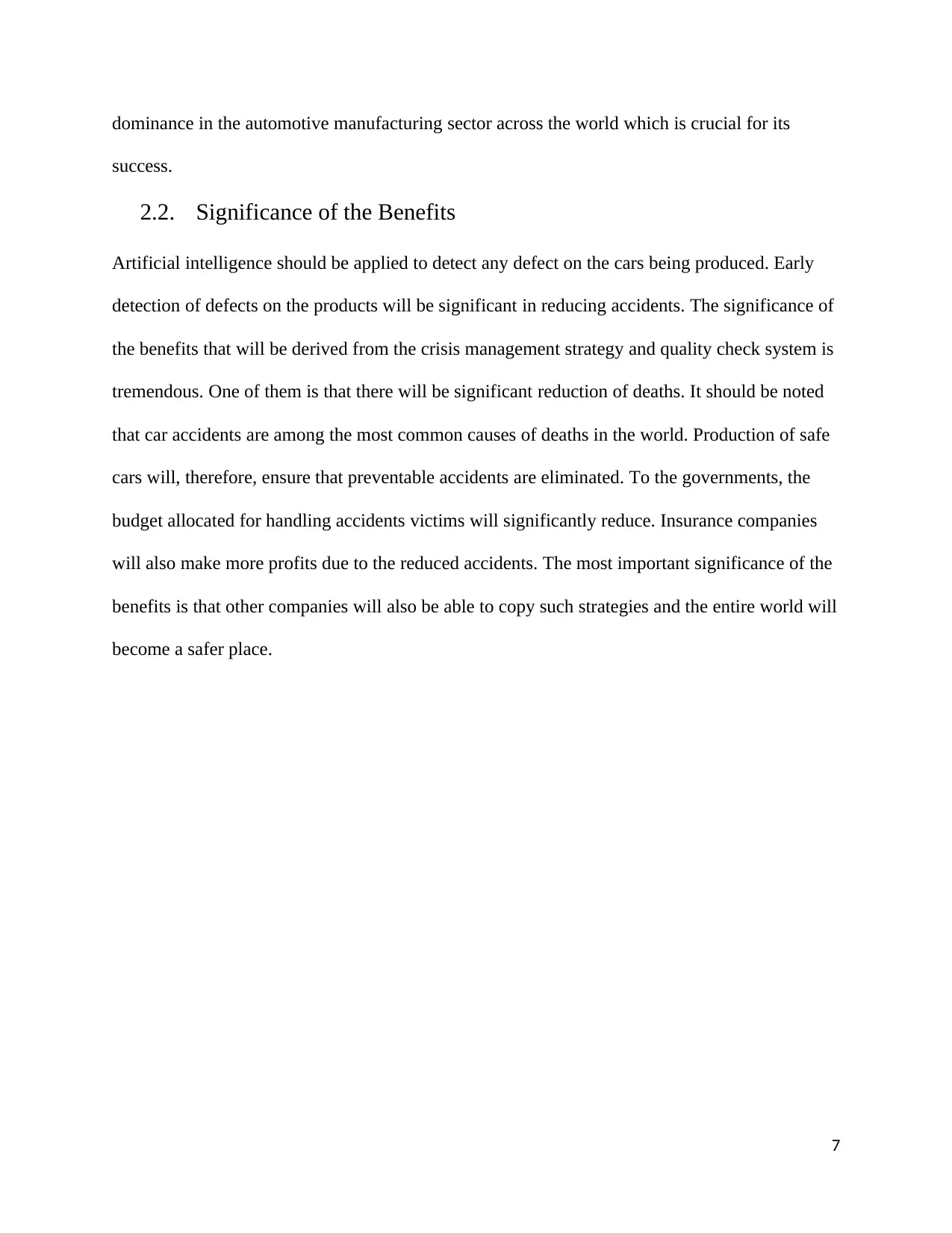
dominance in the automotive manufacturing sector across the world which is crucial for its
success.
2.2. Significance of the Benefits
Artificial intelligence should be applied to detect any defect on the cars being produced. Early
detection of defects on the products will be significant in reducing accidents. The significance of
the benefits that will be derived from the crisis management strategy and quality check system is
tremendous. One of them is that there will be significant reduction of deaths. It should be noted
that car accidents are among the most common causes of deaths in the world. Production of safe
cars will, therefore, ensure that preventable accidents are eliminated. To the governments, the
budget allocated for handling accidents victims will significantly reduce. Insurance companies
will also make more profits due to the reduced accidents. The most important significance of the
benefits is that other companies will also be able to copy such strategies and the entire world will
become a safer place.
7
success.
2.2. Significance of the Benefits
Artificial intelligence should be applied to detect any defect on the cars being produced. Early
detection of defects on the products will be significant in reducing accidents. The significance of
the benefits that will be derived from the crisis management strategy and quality check system is
tremendous. One of them is that there will be significant reduction of deaths. It should be noted
that car accidents are among the most common causes of deaths in the world. Production of safe
cars will, therefore, ensure that preventable accidents are eliminated. To the governments, the
budget allocated for handling accidents victims will significantly reduce. Insurance companies
will also make more profits due to the reduced accidents. The most important significance of the
benefits is that other companies will also be able to copy such strategies and the entire world will
become a safer place.
7
Paraphrase This Document
Need a fresh take? Get an instant paraphrase of this document with our AI Paraphraser
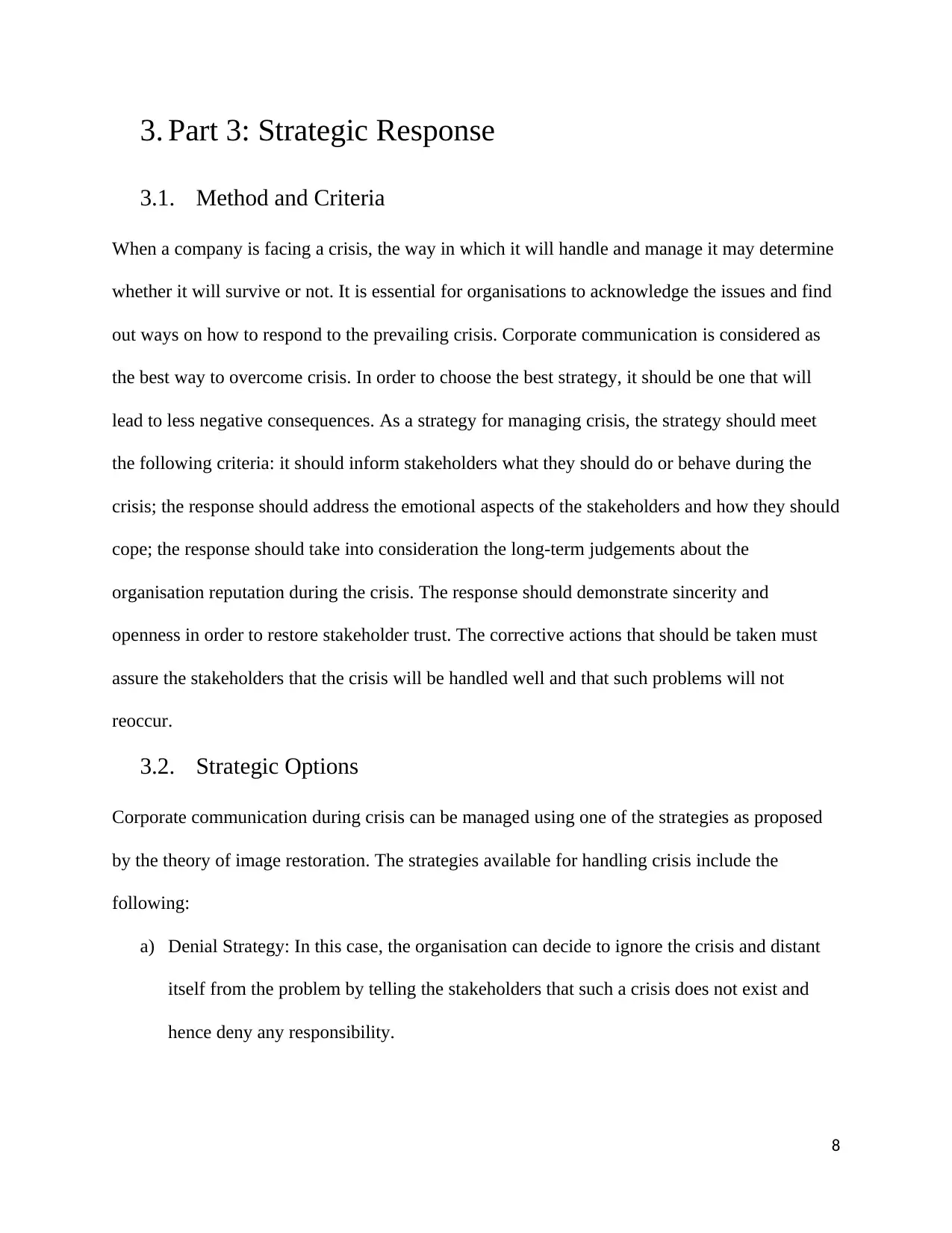
3. Part 3: Strategic Response
3.1. Method and Criteria
When a company is facing a crisis, the way in which it will handle and manage it may determine
whether it will survive or not. It is essential for organisations to acknowledge the issues and find
out ways on how to respond to the prevailing crisis. Corporate communication is considered as
the best way to overcome crisis. In order to choose the best strategy, it should be one that will
lead to less negative consequences. As a strategy for managing crisis, the strategy should meet
the following criteria: it should inform stakeholders what they should do or behave during the
crisis; the response should address the emotional aspects of the stakeholders and how they should
cope; the response should take into consideration the long-term judgements about the
organisation reputation during the crisis. The response should demonstrate sincerity and
openness in order to restore stakeholder trust. The corrective actions that should be taken must
assure the stakeholders that the crisis will be handled well and that such problems will not
reoccur.
3.2. Strategic Options
Corporate communication during crisis can be managed using one of the strategies as proposed
by the theory of image restoration. The strategies available for handling crisis include the
following:
a) Denial Strategy: In this case, the organisation can decide to ignore the crisis and distant
itself from the problem by telling the stakeholders that such a crisis does not exist and
hence deny any responsibility.
8
3.1. Method and Criteria
When a company is facing a crisis, the way in which it will handle and manage it may determine
whether it will survive or not. It is essential for organisations to acknowledge the issues and find
out ways on how to respond to the prevailing crisis. Corporate communication is considered as
the best way to overcome crisis. In order to choose the best strategy, it should be one that will
lead to less negative consequences. As a strategy for managing crisis, the strategy should meet
the following criteria: it should inform stakeholders what they should do or behave during the
crisis; the response should address the emotional aspects of the stakeholders and how they should
cope; the response should take into consideration the long-term judgements about the
organisation reputation during the crisis. The response should demonstrate sincerity and
openness in order to restore stakeholder trust. The corrective actions that should be taken must
assure the stakeholders that the crisis will be handled well and that such problems will not
reoccur.
3.2. Strategic Options
Corporate communication during crisis can be managed using one of the strategies as proposed
by the theory of image restoration. The strategies available for handling crisis include the
following:
a) Denial Strategy: In this case, the organisation can decide to ignore the crisis and distant
itself from the problem by telling the stakeholders that such a crisis does not exist and
hence deny any responsibility.
8
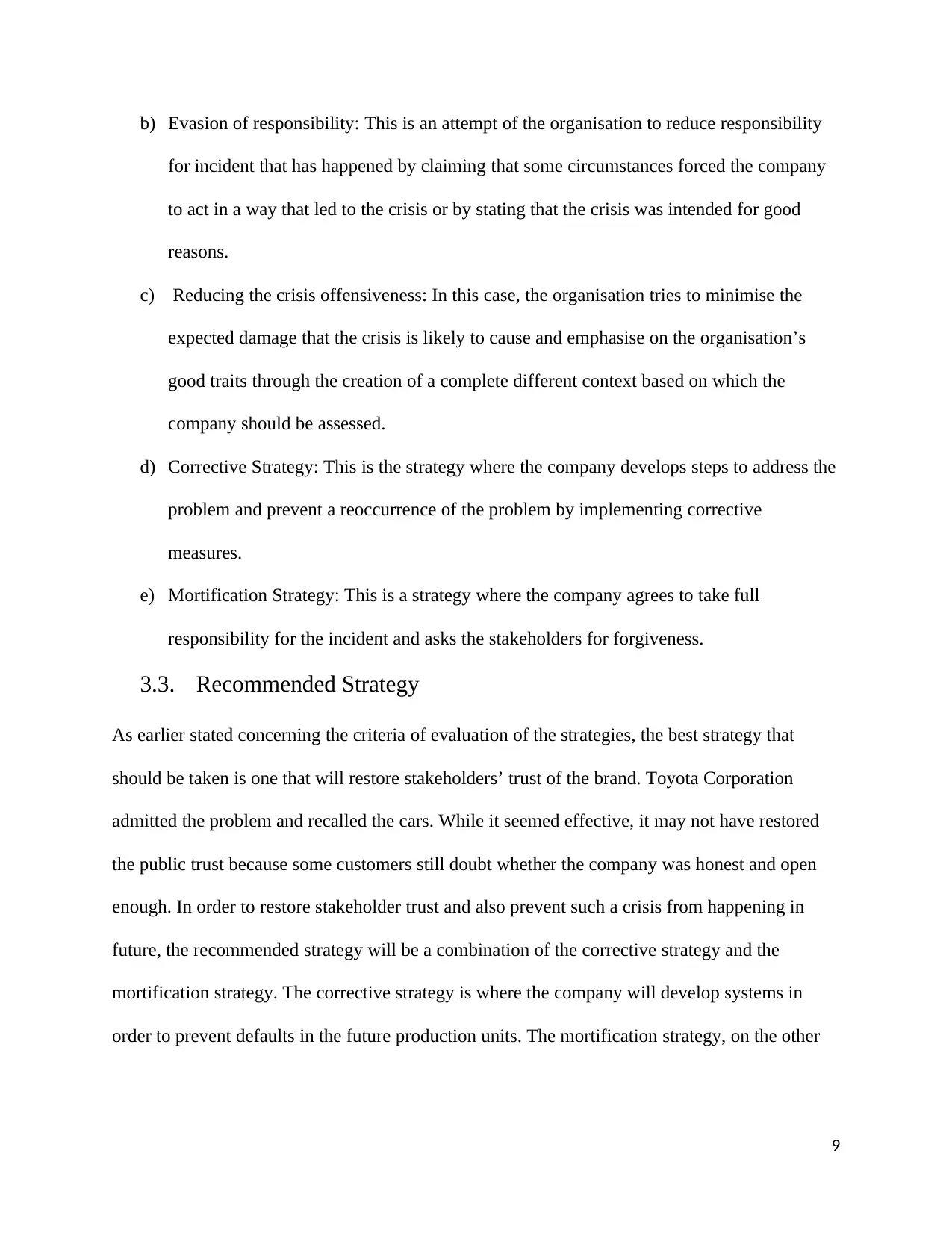
b) Evasion of responsibility: This is an attempt of the organisation to reduce responsibility
for incident that has happened by claiming that some circumstances forced the company
to act in a way that led to the crisis or by stating that the crisis was intended for good
reasons.
c) Reducing the crisis offensiveness: In this case, the organisation tries to minimise the
expected damage that the crisis is likely to cause and emphasise on the organisation’s
good traits through the creation of a complete different context based on which the
company should be assessed.
d) Corrective Strategy: This is the strategy where the company develops steps to address the
problem and prevent a reoccurrence of the problem by implementing corrective
measures.
e) Mortification Strategy: This is a strategy where the company agrees to take full
responsibility for the incident and asks the stakeholders for forgiveness.
3.3. Recommended Strategy
As earlier stated concerning the criteria of evaluation of the strategies, the best strategy that
should be taken is one that will restore stakeholders’ trust of the brand. Toyota Corporation
admitted the problem and recalled the cars. While it seemed effective, it may not have restored
the public trust because some customers still doubt whether the company was honest and open
enough. In order to restore stakeholder trust and also prevent such a crisis from happening in
future, the recommended strategy will be a combination of the corrective strategy and the
mortification strategy. The corrective strategy is where the company will develop systems in
order to prevent defaults in the future production units. The mortification strategy, on the other
9
for incident that has happened by claiming that some circumstances forced the company
to act in a way that led to the crisis or by stating that the crisis was intended for good
reasons.
c) Reducing the crisis offensiveness: In this case, the organisation tries to minimise the
expected damage that the crisis is likely to cause and emphasise on the organisation’s
good traits through the creation of a complete different context based on which the
company should be assessed.
d) Corrective Strategy: This is the strategy where the company develops steps to address the
problem and prevent a reoccurrence of the problem by implementing corrective
measures.
e) Mortification Strategy: This is a strategy where the company agrees to take full
responsibility for the incident and asks the stakeholders for forgiveness.
3.3. Recommended Strategy
As earlier stated concerning the criteria of evaluation of the strategies, the best strategy that
should be taken is one that will restore stakeholders’ trust of the brand. Toyota Corporation
admitted the problem and recalled the cars. While it seemed effective, it may not have restored
the public trust because some customers still doubt whether the company was honest and open
enough. In order to restore stakeholder trust and also prevent such a crisis from happening in
future, the recommended strategy will be a combination of the corrective strategy and the
mortification strategy. The corrective strategy is where the company will develop systems in
order to prevent defaults in the future production units. The mortification strategy, on the other
9
⊘ This is a preview!⊘
Do you want full access?
Subscribe today to unlock all pages.

Trusted by 1+ million students worldwide

hand, will ensure that stakeholders’ trust is restored by admitting the mistakes and taking full
responsibility.
10
responsibility.
10
Paraphrase This Document
Need a fresh take? Get an instant paraphrase of this document with our AI Paraphraser
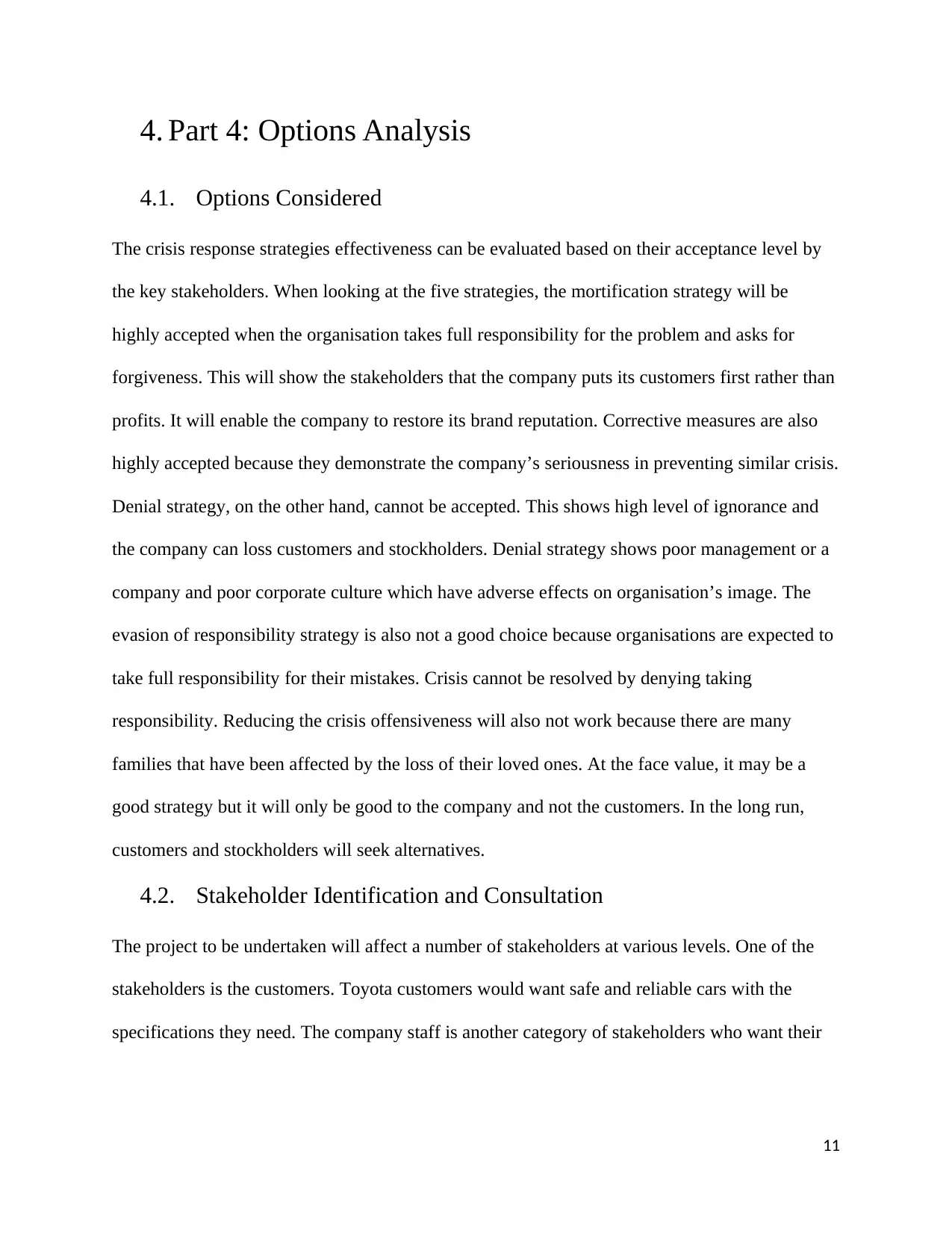
4. Part 4: Options Analysis
4.1. Options Considered
The crisis response strategies effectiveness can be evaluated based on their acceptance level by
the key stakeholders. When looking at the five strategies, the mortification strategy will be
highly accepted when the organisation takes full responsibility for the problem and asks for
forgiveness. This will show the stakeholders that the company puts its customers first rather than
profits. It will enable the company to restore its brand reputation. Corrective measures are also
highly accepted because they demonstrate the company’s seriousness in preventing similar crisis.
Denial strategy, on the other hand, cannot be accepted. This shows high level of ignorance and
the company can loss customers and stockholders. Denial strategy shows poor management or a
company and poor corporate culture which have adverse effects on organisation’s image. The
evasion of responsibility strategy is also not a good choice because organisations are expected to
take full responsibility for their mistakes. Crisis cannot be resolved by denying taking
responsibility. Reducing the crisis offensiveness will also not work because there are many
families that have been affected by the loss of their loved ones. At the face value, it may be a
good strategy but it will only be good to the company and not the customers. In the long run,
customers and stockholders will seek alternatives.
4.2. Stakeholder Identification and Consultation
The project to be undertaken will affect a number of stakeholders at various levels. One of the
stakeholders is the customers. Toyota customers would want safe and reliable cars with the
specifications they need. The company staff is another category of stakeholders who want their
11
4.1. Options Considered
The crisis response strategies effectiveness can be evaluated based on their acceptance level by
the key stakeholders. When looking at the five strategies, the mortification strategy will be
highly accepted when the organisation takes full responsibility for the problem and asks for
forgiveness. This will show the stakeholders that the company puts its customers first rather than
profits. It will enable the company to restore its brand reputation. Corrective measures are also
highly accepted because they demonstrate the company’s seriousness in preventing similar crisis.
Denial strategy, on the other hand, cannot be accepted. This shows high level of ignorance and
the company can loss customers and stockholders. Denial strategy shows poor management or a
company and poor corporate culture which have adverse effects on organisation’s image. The
evasion of responsibility strategy is also not a good choice because organisations are expected to
take full responsibility for their mistakes. Crisis cannot be resolved by denying taking
responsibility. Reducing the crisis offensiveness will also not work because there are many
families that have been affected by the loss of their loved ones. At the face value, it may be a
good strategy but it will only be good to the company and not the customers. In the long run,
customers and stockholders will seek alternatives.
4.2. Stakeholder Identification and Consultation
The project to be undertaken will affect a number of stakeholders at various levels. One of the
stakeholders is the customers. Toyota customers would want safe and reliable cars with the
specifications they need. The company staff is another category of stakeholders who want their
11
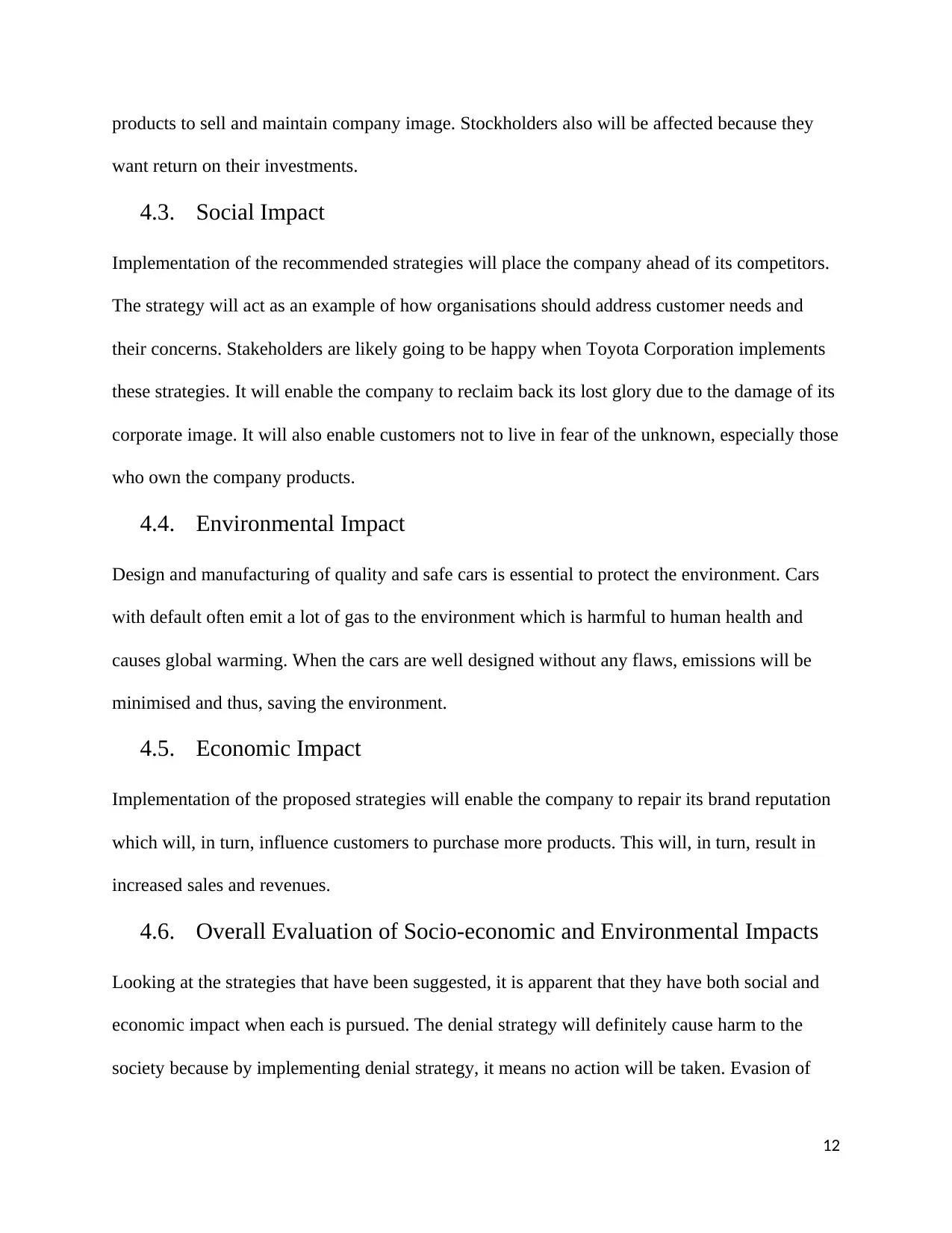
products to sell and maintain company image. Stockholders also will be affected because they
want return on their investments.
4.3. Social Impact
Implementation of the recommended strategies will place the company ahead of its competitors.
The strategy will act as an example of how organisations should address customer needs and
their concerns. Stakeholders are likely going to be happy when Toyota Corporation implements
these strategies. It will enable the company to reclaim back its lost glory due to the damage of its
corporate image. It will also enable customers not to live in fear of the unknown, especially those
who own the company products.
4.4. Environmental Impact
Design and manufacturing of quality and safe cars is essential to protect the environment. Cars
with default often emit a lot of gas to the environment which is harmful to human health and
causes global warming. When the cars are well designed without any flaws, emissions will be
minimised and thus, saving the environment.
4.5. Economic Impact
Implementation of the proposed strategies will enable the company to repair its brand reputation
which will, in turn, influence customers to purchase more products. This will, in turn, result in
increased sales and revenues.
4.6. Overall Evaluation of Socio-economic and Environmental Impacts
Looking at the strategies that have been suggested, it is apparent that they have both social and
economic impact when each is pursued. The denial strategy will definitely cause harm to the
society because by implementing denial strategy, it means no action will be taken. Evasion of
12
want return on their investments.
4.3. Social Impact
Implementation of the recommended strategies will place the company ahead of its competitors.
The strategy will act as an example of how organisations should address customer needs and
their concerns. Stakeholders are likely going to be happy when Toyota Corporation implements
these strategies. It will enable the company to reclaim back its lost glory due to the damage of its
corporate image. It will also enable customers not to live in fear of the unknown, especially those
who own the company products.
4.4. Environmental Impact
Design and manufacturing of quality and safe cars is essential to protect the environment. Cars
with default often emit a lot of gas to the environment which is harmful to human health and
causes global warming. When the cars are well designed without any flaws, emissions will be
minimised and thus, saving the environment.
4.5. Economic Impact
Implementation of the proposed strategies will enable the company to repair its brand reputation
which will, in turn, influence customers to purchase more products. This will, in turn, result in
increased sales and revenues.
4.6. Overall Evaluation of Socio-economic and Environmental Impacts
Looking at the strategies that have been suggested, it is apparent that they have both social and
economic impact when each is pursued. The denial strategy will definitely cause harm to the
society because by implementing denial strategy, it means no action will be taken. Evasion of
12
⊘ This is a preview!⊘
Do you want full access?
Subscribe today to unlock all pages.

Trusted by 1+ million students worldwide
1 out of 21
Related Documents
Your All-in-One AI-Powered Toolkit for Academic Success.
+13062052269
info@desklib.com
Available 24*7 on WhatsApp / Email
![[object Object]](/_next/static/media/star-bottom.7253800d.svg)
Unlock your academic potential
Copyright © 2020–2025 A2Z Services. All Rights Reserved. Developed and managed by ZUCOL.





